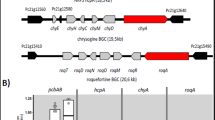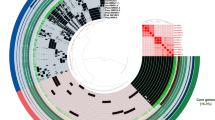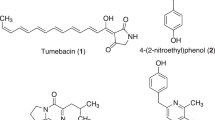Abstract
In the postgenomic era it has become increasingly apparent that the vast number of predicted biosynthesis genes of microorganisms is not reflected by the metabolic profile observed under standard fermentation conditions. In the absence of a particular (in most cases unknown) trigger these gene loci remain silent. Because these cryptic gene clusters may code for the biosynthesis of important virulence factors, toxins, or even drug candidates, new strategies for their activation are urgently needed to make use of this largely untapped reservoir of potentially bioactive compounds1,2. The discovery of new microbial metabolites through genome mining has proven to be a very promising approach3,4,5,6,7,8,9,10,11,12,13,14,15. Even so, the investigation of silent gene clusters is still a substantial challenge, particularly in fungi16. Here we report a new strategy for the successful induction of a silent metabolic pathway in the important model organism Aspergillus nidulans, which led to the discovery of novel PKS-NRPS hybrid metabolites.
This is a preview of subscription content, access via your institution
Access options
Subscribe to this journal
Receive 12 print issues and online access
$259.00 per year
only $21.58 per issue
Buy this article
- Purchase on Springer Link
- Instant access to full article PDF
Prices may be subject to local taxes which are calculated during checkout



Similar content being viewed by others
References
Van Lanen, S.G. & Shen, B. Microbial genomics for the improvement of natural product discovery. Curr. Opin. Microbiol. 9, 252–260 (2006).
Ricke, D.O., Wang, S.W., Cai, R. & Cohen, D. Genomic approaches to drug discovery. Curr. Opin. Chem. Biol. 10, 303–308 (2006).
Lautru, S., Deeth, R.J., Bailey, L.M. & Challis, G.L. Discovery of a new peptide natural product by Streptomyces coelicolor genome mining. Nat. Chem. Biol. 1, 265–269 (2005).
Peric-Concha, N. & Long, P.F. Mining the microbial metabolome: a new frontier for natural product lead discovery. Drug Discov. Today 8, 1078–1084 (2003).
Bode, H.B. & Müller, R. The impact of bacterial genomics on natural product research. Angew. Chem. Int. Ed. 44, 6828–6846 (2005).
McAlpine, J.B. et al. Microbial genomics as a guide to drug discovery and structural elucidation: ECO-02301, a novel antifungal agent, as an example. J. Nat. Prod. 68, 493–496 (2005).
Scherlach, K. & Hertweck, C. Discovery of aspoquinolones A-D, prenylated quinoline-2-one alkaloids from Aspergillus nidulans, motivated by genome mining. Org. Biomol. Chem. 4, 3517–3520 (2006).
Bok, J.W. et al. Genomic mining for Aspergillus natural products. Chem. Biol. 13, 31–37 (2006).
Song, L. et al. Type III polyketide synthase β-ketoacyl-ACP starter unit and ethylmalonyl-CoA extender unit selectivity discovered by Streptomyces coelicolor genome mining. J. Am. Chem. Soc. 128, 14754–14755 (2006).
Sudek, S., Haygood, M.G., Youssef, D.T. & Schmidt, E.W. Structure of trichamide, a cyclic peptide from the bloom-forming cyanobacterium Trichodesmium erythraeum, predicted from the genome sequence. Appl. Environ. Microbiol. 72, 4382–4387 (2006).
Banskota, A.H. et al. Isolation and identification of three new 5-alkenyl-3,3(2H)-furanones from two Streptomyces species using a genomic screening approach. J. Antibiot. (Tokyo) 59, 168–176 (2006).
Banskota, A.H. et al. Genomic analyses lead to novel secondary metabolites. Part 3. ECO-0501, a novel antibacterial of a new class. J. Antibiot. (Tokyo) 59, 533–542 (2006).
Fazio, G.C., Xu, R. & Matsuda, S.P. Genome mining to identify new plant triterpenoids. J. Am. Chem. Soc. 126, 5678–5679 (2004).
Wenzel, S.C. et al. Structure and biosynthesis of myxochromides S1–3 in Stigmatella aurantiaca: evidence for an iterative bacterial type I polyketide synthase and for module skipping in nonribosomal peptide biosynthesis. ChemBioChem 6, 375–380 (2005).
Tohyama, S. et al. Genome-inspired search for new antibiotics. Isolation and structure determination of new 28-membered polyketide macrolactones, halstoctacosanolides A and B, from Streptomyces halstedii HC34. Tetrahedron 60, 3999–4005 (2004).
Schümann, J. & Hertweck, C. Advances in cloning, functional analysis and heterologous expression of fungal polyketide synthase genes. J. Biotechnol. 124, 690–703 (2006).
Galagan, J.E. et al. Sequencing of Aspergillus nidulans and comparative analysis with A. fumigatus and A. oryzae. Nature 438, 1105–1115 (2005).
Sims, J.W., Fillmore, J.P., Warner, D.D. & Schmidt, E.W. Equisetin biosynthesis in Fusarium heterosporum. Chem. Commun. (Camb.) 186–188 (2005).
Song, Z., Cox, R.J., Lazarus, C.M. & Simpson, T.J. Fusarin C biosynthesis in Fusarium moniliforme and Fusarium venenatum. ChemBioChem 5, 1196–1203 (2004).
Dean, R.A. et al. The genome sequence of the rice blast fungus Magnaporthe grisea. Nature 434, 980–986 (2005).
Bohnert, H.U. et al. A putative polyketide synthase peptide synthetase from Magnaporthe grisea signals pathogen attack to resistant rice. Plant Cell 16, 2499–2513 (2004).
Gaffoor, I. et al. Functional analysis of the polyketide synthase genes in the filamentous fungus Gibberella zeae (Anamorph Fusarium graminearum). Eukaryot. Cell 4, 1926–1933 (2005).
Kennedy, J. et al. Modulation of polyketide synthase activity by accessory proteins during lovastatin biosynthesis. Science 284, 1368–1372 (1999).
Waring, R.B., May, G.S. & Morris, N.R. Characterization of an inducible expression system in Aspergillus nidulans using alcA and tubulin-coding genes. Gene 79, 119–130 (1989).
Stahl, M., Schopfer, U., Frenking, G. & Hoffmann, W. Assignment of relative configuration to acyclic compounds based on 13C NMR shifts. A density functional and molecular mechanics study. J. Org. Chem. 61, 8083–8088 (1996).
Clark, A.J. & Ellard, J.M. Synthesis of the C9–C25 fragment of L-755,807. Evidence for the relative configuration of the side chain. Tetrahedron Lett. 39, 6033–6036 (1998).
Schmidt, K., Riese, U., Li, Z. & Hamburger, M. Novel tetramic acids and pyridone alkaloids, militarinones B, C, and D, from the insect pathogenic fungus Paecilomyces militaris. J. Nat. Prod. 66, 378–383 (2003).
McInnes, A.G., Smith, D.G., Wat, C.K., Vining, L.C. & Wright, J.L.C. Tenellin and bassianin, metabolites of Beauveria species - structure elucidation with N-15-enriched and doubly C-13-enriched compounds using C-13 nuclear magnetic-resonance spectroscopy. J. Chem. Soc. Chem. Commun. 281–282 (1974).
Cheng, Y. et al. Farinosones A-C, neurotrophic alkaloidal metabolites from the entomogenous deuteromycete Paecilomyces farinosus. J. Nat. Prod. 67, 1854–1858 (2004).
Moore, M.C., Cox, R.J., Duffin, G.R. & O'Hagan, D. Synthesis and evaluation of a putative acyl tetramic acid intermediate in tenellin biosynthesis in Beauveria bassiana. A new role for tyrosine. Tetrahedron 54, 9195–9206 (1998).
Fujita, Y., Oguri, H. & Oikawa, H. Biosynthetic studies on the antibiotics PF1140: a novel pathway for a 2-pyridone framework. Tetrahedron Lett. 46, 5885–5888 (2005).
Lang, G., Blunt, J.W., Cummings, N.J., Cole, A.L. & Munro, M.H.G. Paecilosetin, a new bioactive fungal metabolite from a New Zealand isolate of Paecilomyces farinosus. J. Nat. Prod. 68, 810–811 (2005).
Eley, K.L. et al. Biosynthesis of the 2-pyridone tenellin in the insect pathogenic fungus Beauveria bassiana. Chembiochem 8, 289–297 (2007).
Herrmann, M., Sprote, P. & Brakhage, A.A. Protein kinase C (PkcA) of Aspergillus nidulans is involved in the penicillin production. Appl. Environ. Microbiol. 72, 2957–2970 (2006).
Acknowledgements
We thank A. Perner for MS and HPLC/MS measurements, F.A. Gollmick for NMR measurements, and M.-G. Schwinger for strain cultivation. Financial support by the Leibniz Gemeinschaft, the Deutsche Forschungsgemeinschaft and the European Union (Euketides network) is gratefully acknowledged.
Author information
Authors and Affiliations
Contributions
S.B. and J.S. carried out the molecular studies; K.S. and C.L. performed structural elucidation; A.B. and C.H. designed the experiments and wrote the article.
Corresponding author
Ethics declarations
Competing interests
The authors declare no competing financial interests.
Supplementary information
Supplementary Fig. 1
Gene expression profiling by northern blot analysis. (PDF 179 kb)
Supplementary Fig. 2
One-dimensional and two-dimensional NMR spectra of aspyridone A and HPLC profile. (PDF 138 kb)
Supplementary Table 1
Proposed functions of the apd gene products. (PDF 105 kb)
Supplementary Table 2
Bacterial and fungal strains and plasmids used in this study. (PDF 53 kb)
Supplementary Table 3
Oligonucleotides used in this study. (PDF 10 kb)
Rights and permissions
About this article
Cite this article
Bergmann, S., Schümann, J., Scherlach, K. et al. Genomics-driven discovery of PKS-NRPS hybrid metabolites from Aspergillus nidulans. Nat Chem Biol 3, 213–217 (2007). https://doi.org/10.1038/nchembio869
Received:
Accepted:
Published:
Issue Date:
DOI: https://doi.org/10.1038/nchembio869
This article is cited by
-
Bioactive compounds and biomedical applications of endophytic fungi: a recent review
Microbial Cell Factories (2023)
-
Streptomyces polyketides mediate bacteria–fungi interactions across soil environments
Nature Microbiology (2023)
-
Improved polyketide production in C. glutamicum by preventing propionate-induced growth inhibition
Nature Metabolism (2023)
-
Quantitative characterization of filamentous fungal promoters on a single-cell resolution to discover cryptic natural products
Science China Life Sciences (2023)
-
One-pot Biginelli synthesis of novel series of 2-oxo/thioxo/imino-1,2,3,4-tetrahydropyrimidine based on 4-hydroxy-2-pyridone
Chemical Papers (2023)



